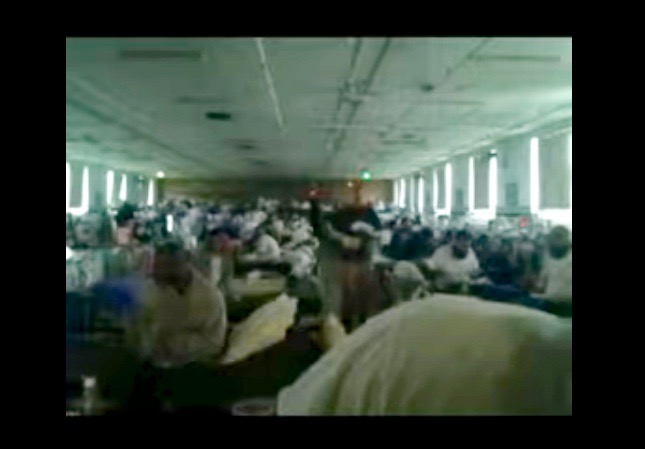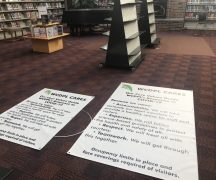As Ohio’s government orders businesses closed and residents inside for their own safety, state prisons facing spiraling outbreaks remain crowded and cramped, videos and interviews show.
At Marion Correctional Institution, which houses 2,500 inmates but was built for about 1,650, 44 prison employees have tested positive for the virus as of Friday, one of whom has died. Meanwhile, 11 prisoners have tested positive and another 11 are in isolation. The MCI outbreak was first detected March 29.
Michael Powell Jr., an inmate, said in a Tuesday video call with an acquaintance, provided to the Ohio Capital Journal, that men inside are coughing and running fevers. It’s crowded, he said, and they’re set to run out of soap and hand sanitizer any day.
Wearing a polka-dot mask, Powell at one point in the call leans out of the frame, showing a crowded, dormitory style area with dozens of men milling about.
“All the necessary precautions are out the window,” Powell said. “There’s a few dudes in here right now who got fevers who they’re not testing or taking out of here. It’s pandemonium in the pandemic. It’s really, really bad right now.”
Powell has been incarcerated since 2008 under charges of kidnapping and aggravated robbery. His term ends in 2026.
Experts agree jails and prisons, which are often overcrowded and unsanitary, offer prime conditions for the virus to leap between inmates and workers alike.
The governor and a spokeswoman for the Ohio Department of Rehabilitation and Correction acknowledged prisoners are prone to the virus, but insist they have taken several steps to prevent transmission.
There are about 49,000 inmates in Ohio’s 28 prisons, and nearly 11,000 staff. More than 22,000 inmates were released in 2019, a show of the regular shuffle in and out of the facilities.
Dustin Miller, another MCI inmate, is worried as well. He emailed his sister, Melisa, measurements taken to show the impossibility of social distancing in prison.
His measurements from bed to bed? 32 inches. The four-man dinner tables inmates share? 46 inches, end-to-end. Urinal to urinal? 23 inches.
“There is no social distancing capabilities in here,” he said.
Melisa Miller provided her brother’s emails to the Capital Journal.
“Our brave staff (of whom I respect), are in serious danger, the men and women in these institutions will more than ‘likely’ contract this virus — turning these overcrowded facilities into a well-formulated petri dish, allowing the coronavirus ‘to spread,’ incubate or culture, which will (then) be consistently released to all 88 counties,” he wrote.
Dustin Miller is serving a six year term for engaging in corrupt acts. He is scheduled for release in December 2020.
The problems aren’t just in Marion. At least 38 prisoners have confirmed cases of COVID-19 statewide. Nearly 40 tests are pending, and 77 prisoners are in isolation, as of Friday afternoon.
At least 74 prison workers have confirmed cases as well, one of whom died this week.
Ten prisons, housing more than 14,000 inmates, are in institution-wide quarantine.
At London Correctional Institution where there are no confirmed cases but one inmate in isolation. Dion Evans, an inmate, is concerned inmates are seen as “expendable.”
He said some men inside are on the tail end of long sentences but could die inside if the virus infiltrates the prison walls. And he’s worried how people will react when that happens.
“We are here, afraid that things are going to get worse, and before long, people are going to start turning up, man,” he said. “When coronavirus hits here like it just hit Marion and Pickaway, people are going to start hurting individuals man, cause they’re afraid. Something needs to get done. People need to start getting released back to their families.”
Evans has been incarcerated since 2006 on theft, burglary, possession, and other charges. He is eligible for early release next year.
Kevin Ballou, a former MCI inmate and friend of Powell and Evans, provided the videos. He said he did so to apply public pressure to release inmates before the outbreak worsens.
In Washington state, state and local police were called in to bring a large disturbance under control after several hundred inmates at a prison, concerned about the facility’s COVID-19 outbreak, threatened to set fires and possibly take corrections officers hostage, according to The Seattle Times. Six inmates in the facility had confirmed cases at the time.
Ohio Gov. Mike DeWine has said that prisons face unique challenges amid the pandemic and acknowledged the difficulty of social distancing inside. He has recommended the release of a narrow slate of 205 inmates, of 49,000 the state houses.
The ACLU of Ohio and others have called for the release of thousands of prisoners before the prison epidemic grows out of control.
Meanwhile, an inmate at Belmont Correctional Institution filed a lawsuit in the Ohio Supreme Court seeking release. He says he’s HIV positive and the virus could kill him before his 30-month sentence is up. The lawsuit is ongoing.
In court filings, inmate Derek Lichtenwalter notes state prisons violate many aspects of Ohio’s public health orders for the general public.
DeWine said Friday the state will soon be testing every prisoner in certain viral “hotspots.” He said no one is safe from the disease, but the state has a duty to slow the spread of the virus.
“We have a responsibility to DRC employees, we have a responsibility to the prisoners who are in our care, and we will do everything that we can to try to keep them safe,” he said.
Ohio Department of Rehabilitation and Corrections spokeswoman JoEllen Smith said in a statement that responding the outbreak “continues to be a priority” and emphasized mitigating steps the department has taken, like allowing the use of masks in prisons, banning visitors, taking the temperatures of entrants, and restricting inmates’ movement and others.
“The Director communicates daily with the wardens across the state and emphasizes the importance of social distancing when it is possible in a correctional setting,” she said.





